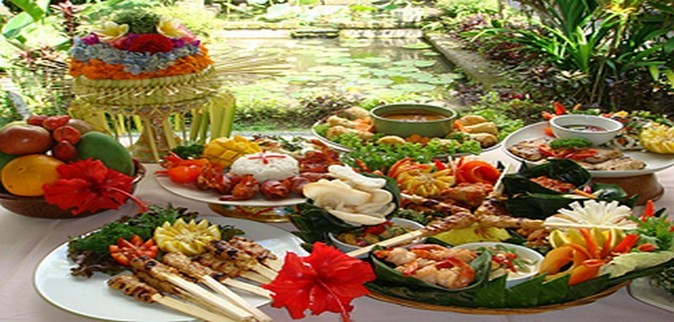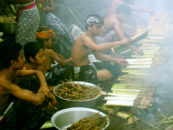Kompas.com recently compiled a list of 15 authentically Balinese dishes to guide culinary explorers visiting the Island.
Use this list to create a “checklist” of “must-try” dishes to seek out on a trip to Bali.
Sate Lilit

The Balinese approach to the famous Southeast Asian dish of Sate (Satay) varies in some basic ways from this skewered meat dish served in other parts of the region. Unlike sate served in Java and other areas where chunks of marinated meat are lanced onto bamboo skewers, the Balinese prefer to mince meat or seafood mixed with local spices folded around broad skewers of bamboo or lemon grass before being delicately roasted over charcoal. The Indonesia-wide tendency to ladle peanut sauce over freshly roasted meat or seafood is not done by the Balinese, who prefer to eat their satay “as is” or only drizzled in soy sauce.
Easily found in many roadside warungs and restaurants, Sate Bali is made from chicken, beef, pork, or minced mackerel (tenggiri).
Nasi Campur Bali

“Nasi Campur” (pronounced ‘Champur’) is a “code name” generalization for the way Indonesians from the East in Sabang, Aceh Province, to Merauke in the westernmost province of Papua eat a nutritious and delicious meal. “Nasi Campur” refers to a bountiful plate of cooked white rice that serves as a base for spoonfuls of local meats, curries, vegetables, and sambals, usually complemented with a krupuk prawn cracker.
“Nasi Campur Bali” becomes the gathering point for several Balinese dishes mentioned in this article, which might be served with several sticks or two of sates, ayam betutu, ayam pelalah, lawar, serombatan, and jukut ares. The Bali variant of “Nasi Campur” almost always includes the condiments of “sambal mata” – the quintessentially Balinese take on spicy sambal.
In days past, pork dishes would be included in “Nasi Campur Bali,” many famous restaurants in Bali serve a non-pork version in deference to the “halal tastes” of many domestic and foreign visitors.
Nasi Jinggo
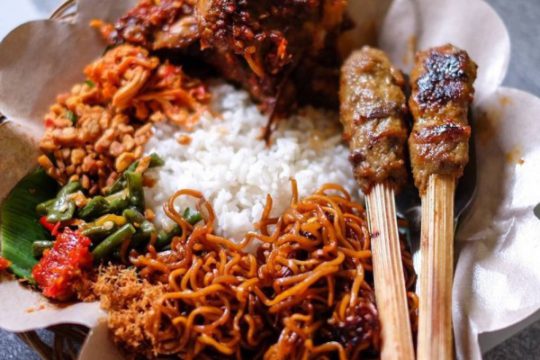
Also known as “nasi jinggo” this dish might be called the “poor man’s answer to Nasi Campur.” Served in tidy pockets of folded banana leaf, Nasi Jinggo stands are found on roadsides, doing a brisk trade with passing truckers and students, with each packet containing a small portion of chicken and vegetables costing only Rp. 5,000 a serving.
Nasi Jinggo is popular as a quick-fix breakfast snatched on the way to class or the workplace.
Those searching for Nasi Jinggo might find even lower prices of, say, Rp. 1,500. Back in the day, this dish’s price and name were eponymous; in the Hokkien dialect of Chinese, jeng go means “one and one-half,” or literally 1,500. When bargaining for anything in a local market in Indonesia, exclaiming “jeng go” might just net you a price of Rp. 1,500.
Ayam Betutu
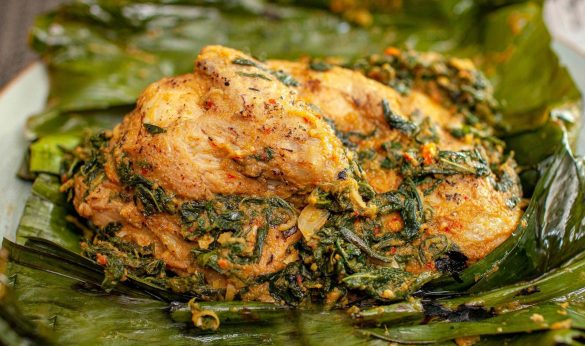
Betutu is a cooking style of chicken or duck (Bebek Betutu). A chicken or duck carcass is stuffed with Balinese herbs and spices, and wrapped in banana or palm leaves, before being slow-roasted over charcoal coals. The resulting dish is tasty, spicy, and aromatic.
Ayam or Bebek Betutu was once a dish served only at religious celebrations but is now enjoyed daily across the Island of Bali.
Serambotan

A delicious Balinese vegetable side dish with many ingredients closely resembling another popular local dish – urap, Serambotan is prepared with blanched local spinach, water spinach (kankung), string beans, green beans, bean sprouts, round eggplant (terong bulat), and bitter gourd. The accompanying sauce combines turmeric, aromatic ginger (kencur), galangal, and a spicy peanut sauce.
Adding to its culinary perfection, a dollop of chili sauce (sambal) crowns this dish.
Bubur Mengguh

A favorite form of rice porridge, Bubur Mengguh see rice boiled to a porridge consistency complemented with shredded spicy chicken (ayam suwir), pieces of roast chicken, and a spoonful of spices – all mixed with a thick chicken broth.
This dish hails from the north Balinese regency of Buleleng.
Sate Plecing

This type of sate originates from Singaraja, the former capital of Bali, located on the Island’s north shore.
Made with beef or goat meat, the spice, and tangy meat is marinated in a mixture of garlic, shallots, red pepper chilis, candle nut (kemiri), palm sugar, fermented shrimp paste, ground coriander, lime juice (jeruk limau), salt and sweet soy sauce.
After a thorough marination of at least 30 minutes, the pieces of meat are threaded onto bamboo sticks and roasted to char-broiled perfection.
Bebek Timbungan

Bebek Timbungan is a roast duck disk that is infrequently encountered, perhaps due to the 12 hours needed for its preparation.
One restaurant that prepares Bebek Timbungan as a signature dish is Restaurant Bebek Timbungan which features it as a “Balinese Heritage Cuisine” at the Secret Garden Village in Bedugul, Bali .
The duck meat is cooked for about 12 hours in selected spices. Initially, the duck is covered and marinated in the spices for a minimum of 4 hours before being steamed for a further 8 hours. Older ducks are typically used with a longer cooking time over a low heat necessary to tenderize the final product and ensure a thorough saturation with the spices.
The spice used include chilies, ginger, and shredded coconut meat.
Tum Ayam
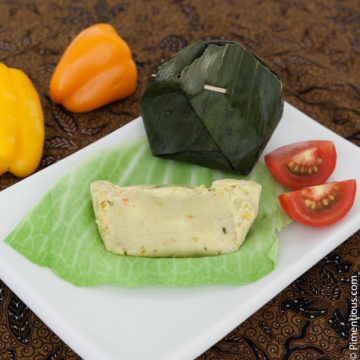
Balinese spices (base genep) are mixed with minced chicken meat and then wrapped in banana leaves to be slow-steamed with the end product resembling a European terrine or another Indonesian dish – Pepes. Delicious in the extreme.
Lawar

Lawar, in all its forms, is a dish often identified with Bali. At its most basic, Lawar is a mixture of ground meat and a selection of vegetables mixed with shredded coconut and spices. The original recipe uses pork, sometimes augmented with pork blood.
Those who, for whatever reason, don’t eat pork can enjoy the “halal” varieties of lawar using chicken or free-range wild duck (bebek entong).
Traditional Lawar prepared in Bali comes in two varieties: Red lawar (lawar merah) and white lawar (lawar putih). Lawar merah acquires its red color from being mixed with animal blood.
Tipat Cantok

Tipat is the Balinese term for the Javanese term –“Ketupat,” the name for boiled rice cakes. Pieces of “Tipat” are cut up and mixed with blanched green beans, water spinach, bean sprouts, and cucumbers slathered in a peanut sauce containing garlic, chilis, salt, and fermented yellow soy bean sauce (tauco).
Rujak Bulang and Kuah Pindang
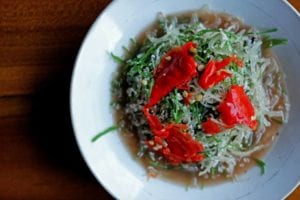
Rujak is the name of a salad made from sliced fruits and vegetables served with a spicy palm sugar sauce. Rujak Bulang is found only in Bali, where the fruits and vegetables are also basted in a tuna fish broth. Rujuk Bulang also has a unique character due to the use of seaweed (bulung), young unripe mangoes, yams, and water apples (kedondong) served in a spicy sauce that includes tuna fish broth ( Kuah Pindang).
Tipat blyang
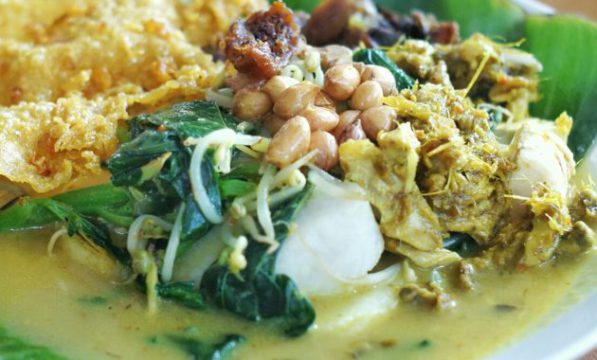
Tipat blyang originates from Buleleng Regency in North Bali. Rice cakes (lontong) are cut into small pieces that complement bean sprouts, blanched vegetables (urap sayuran), shredded spicy chicken, and fried peanuts served in a chicken broth. A sliced hard-boiled egg, fried shallots, and fried nutcrackers (penyet) are added as a condiment.
A portion of Tipat blyang will cost around Rp. 10,000.
Komoh
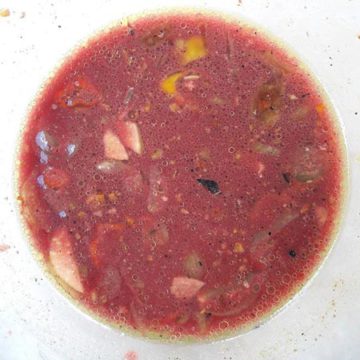
Komoh is a Balinese soup that uses meat as its base. The meat can be chicken, duck, or pork, and on occasion, Komoh includes organ meat (offal) and the skin of various animals.
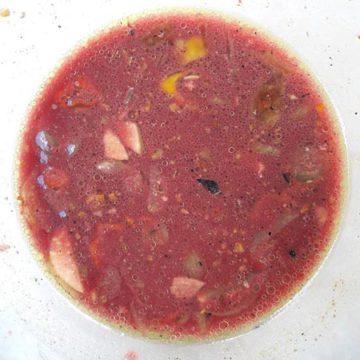

Jukut ares
Jukut ares is made from the stems of young banana trees (ares) thinly sliced before cooking in a Balinese spice base. Chicken, duck, or pork are added to this delicious broth.
Related Articles
7 Essential Bali Addresses for Babi Guling
Value & Flavorful: 5 Bali Dining Spots
Stay Informed on Bali Tourism-Related News: Subscribe to Bali Update

